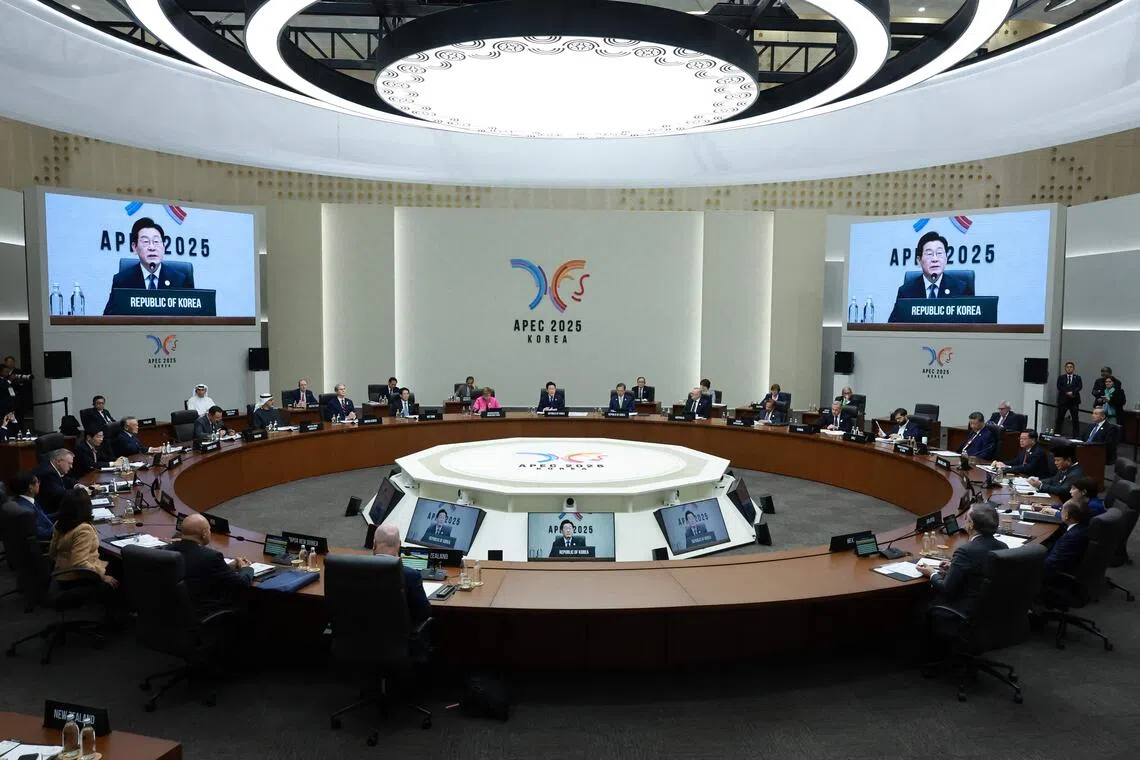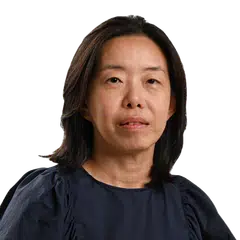Trade tensions threaten to overshadow Apec meetings as leaders seek consensus
Sign up now: Get ST's newsletters delivered to your inbox

South Korean President Lee Jae Myung speaking at the Apec Economic Leaders’ Meetings in the South Korean city of Gyeongju on Oct 31.
PHOTO: AFP
Follow topic:
- Trump's trade protectionism looms over Apec, raising concerns that there may not be a joint communique as was the case in 2018 due to US-China trade tensions.
- A temporary US-China truce was reached, with the US easing tariffs and China addressing fentanyl and rare earth exports, but its impact on Apec remains uncertain.
- Xi Jinping urged Apec to uphold free trade amid "increasing instability", while Singapore called for WTO reform and South Korea emphasised harmony for shared prosperity.
AI generated
GYEONGJU - Despite US President Donald Trump’s absence from the ongoing Asia-Pacific Economic Cooperation (Apec) meetings in the South Korean city of Gyeongju, his shadow looms large.
All eyes are on whether the 21 member economies will be able to issue a joint communique when the annual meetings conclude on Nov 1, or if it will end as it did at the 2018 Apec summit in Papua New Guinea, without a joint statement for the first time in the forum’s 30-year history.
The 2018 deadlock occurred amid the outbreak of the US-China trade war, when Mr Trump, during his first term, imposed tariffs on billions of dollars worth of Chinese goods, prompting retaliation from Beijing.
At the 2018 forum that Mr Trump had also skipped, his officials pressed for tougher language on unfair trade practices and World Trade Organisation (WTO) reforms, while China objected to being singled out.
A compromise could not be brokered, and the forum concluded that year without a declaration, which can only be adopted by consensus, with support from every single member.
Seven years later, the circumstances are strikingly similar.
Mr Trump is back with his protectionist policies and is even more aggressive this time around, slapping tariffs on nearly every country in the world just weeks after beginning his second presidential term in January.
Prior to his summit with Chinese President Xi Jinping
To the world’s relief, the two leaders announced a temporary truce, with the US agreeing to ease tariffs
But whether the suspension of trade hostilities will translate into an Apec declaration this time round remains to be seen.
South Korean Foreign Minister Cho Hyun painted an optimistic picture on Oct 30, telling reporters at a press conference that the member economies “are very close” to finalising one, tentatively titled the Gyeongju Declaration.
But he declined to provide details, citing last-minute negotiations.
Just a week ago, on Oct 24, he had been more apprehensive, saying in a radio interview that “whether to include language emphasising free trade” was a point of contention among the member economies at that time.
As in 2018, Mr Trump has chosen to skip the Apec Economic Leaders’ Meetings in 2025
The US is represented at the Apec forum by Treasury Secretary Scott Bessent instead.
At a press briefing on Oct 31, a senior US official in charge of Apec, Mr Casey Mace, told reporters that “fair trade” remains a priority for the US, and that “President Trump and the Trump administration are serious, committed, and understand the value of Apec”.
When asked about the joint statement, Mr Mace said: “We are doing our best to achieve a strong consensus that reflects global economic efforts and priorities to boost regional growth.”
In Mr Trump’s absence, Mr Xi took centre stage at the opening session of the leaders’ meetings
When Mr Xi entered the meeting venue, a few leaders, such as Vietnam’s President Luong Cuong and Malaysian Prime Minister Anwar Ibrahim, walked over to Mr Xi’s seat to welcome him warmly.
In his remarks, Mr Xi urged Apec members to “practise true multilateralism, and enhance the authority and effectiveness of the multilateral trading system with the WTO at its core”.
In an apparent swipe at Mr Trump, the Chinese leader reminded members to “uphold Apec’s original mission” of free trade and pull together, especially in times of “increasing instability and uncertainty”.
The multilateral forum was founded in 1989 to champion free and open trade and investment. While the US is a founding member, China joined only in 1991.
Singapore is also among the founding members of Apec.
In his remarks, Singapore’s Prime Minister Lawrence Wong urged the Apec leadership to reform and strengthen the WTO
South Korea, as host, urged harmony among members.
In his opening speech
He also highlighted the significance of the conference venue as the setting for the Apec meetings.
The Hwabaek International Convention Centre in Gyeongju, where the meetings are being held, is named after the Hwabaek Council of the ancient Silla Kingdom, which oversaw the most important state affairs and made decisions only by unanimous agreement.
Said Mr Lee: “The ‘Hwabaek’ spirit does not force unanimous thinking. The Silla Hwabaek spirit seeks harmony and a path of mutual prosperity, pursuing a symphony of harmony created by different voices coming together.”
The Apec meetings conclude on Nov 1, and South Korea will hand over the chairmanship to China, which will host Apec in 2026.


